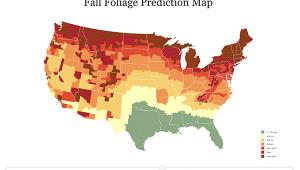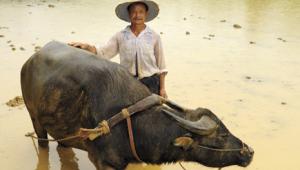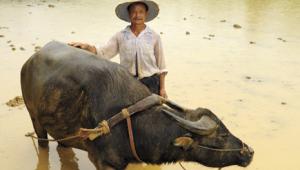After Dark
What To Do When The Light Runs Out
| Where are alternatives to on-camera flash. Understanding this is one of the defining moments in most photographers' progress. Up to a certain point, you just turn on the flash, or shrug and say, "There isn't enough light." Then, one day--like a light coming on, if you will pardon the simile--you realize that if other people can get pictures in next to no light, so can you. The very simplest option is just to give longer exposures, using a tripod or other camera support, including resting the camera on a wall. Even a box camera can be used for night shots, if you give a long enough exposure. The main things to watch out for are subject movement--anything that moves during the exposure will of course register as a blur--and "reciprocity failure." Reciprocity Effects There are however plenty of occasions when the somewhat leisurely approach of extending the exposure indefinitely will not do. At this point, in escalating order of cost, you need faster film; faster lenses; and (if you want to hand hold the image) more suitable cameras. Also, regardless of the approach you use--fast film, fast lenses, tripods, rangefinder cameras, or any combination thereof--there are techniques of metering and composition that will help you get better pictures in poor light. Fast Film The fastest true ISO speeds (1600 and even 3200) are found in color negative. Among color slide films, the norm is to start with a relatively slow film (EI 400, 200, or even 100) and then "push process" to EIs as high as 1000 or beyond. Fuji's excellent RSP, for example, is an ISO 400 film that delivers very good results at EI 800 to 1600, and acceptable results as high as 3200, while Kodak's Ektachrome 200 is excellent at its rated speed, still superb at EI 320 (which you get instead of 400 at push 1), very good at EI 640 (push 2) and quite good at EI 1000 (push 3). Perhaps surprisingly, there is no great need to worry about the lighting balance. I have used both daylight-balanced and tungsten-balanced slide films in low light, and daylight almost invariably looks more natural. If you are shooting print film, of course, you can adjust the color balance at the printing stage. If black and white is your bag, then you have a choice of pushing mid-speed films, or buying seriously fast films and then pushing them. Ilford's HP5 Plus is normally ISO 400, but can deliver a true ISO 650 (with full shadow detail) in Microphen or a similar "push" developer. When pushed, it gives excellent results at EI 1000 and usable results at 1600; there are even those who push it to 3200. Fuji's Neopan 1600 is about 1/3 stop faster: in other words, it's EI 1600, not ISO 1600. An EI or Exposure Index is a working speed which may or may not correspond to ISO conditions of contrast and shadow detail. The seriously fast films are Kodak TMZ P3200 (ISO 800-1000) and Ilford Delta 3200 (ISO 1000-1250), both of which work better when pushed than when processed to ISO specifications, hence the EI 3200 ratings. Depending on what sort of images you like, both can be pushed to EI 12,500 or even 25,000. For maximum image quality, most people reckon on EI 2000 to 3200, or 6400 at a pinch. Fast Lenses If you use zooms, switching to prime lenses can give you a lot more speed. With most zooms, f/2.8 is fast, and even f/3.5 is not unusually slow. With prime lenses, f/2, f/1.8, and f/1.7 are commonplace; f/1.5 and f/1.4 are not unusual; and f/1.2 and even f/1 are not unknown. In other words, you can gain up to three stops even as compared with a fast zoom. Combine a fast film and a fast lens and you can be six stops or more ahead, the difference between 1/60 sec at f/1.4 and a full sec at f/2.8. After many years' experience with lenses up to f/1.2--I have never used an f/1 in anger--I have come to the conclusion that you can go too fast. Depth of field becomes so small that focusing is problematical. With a 50mm "standard" lens, I prefer not to go faster than about f/1.8, though I will go to f/1.5 or f/1.4 if I must. I actually sold my 50mm f/1.2 Nikkor because it was of such limited usefulness. With a 35mm, I love my f/1.4 Leica Summilux (pre-aspheric) but quite honestly the Voigtlnder f/1.7 Ultron is a better lens and I rarely miss the half stop. It is also worth knowing that the "one over focal length" rule is too generous at longer focal lengths, and too restrictive at shorter focal lengths, so wide angles are a better bet for low light. I get a higher proportion of sharp shots at 1/30 sec with a 35mm lens than I do at 1/60 sec with a 50mm, and with a 21mm I am fairly confident at 1/15 sec and surprisingly often successful at 1/8 sec. With larger formats than 35mm, the "one over focal length" rule does not apply at all. For example, I have an 80mm f/2.8 lens on my 6x7cm Graflex XLRF: about the equivalent of 40mm on 35mm, insofar as different format shapes can be compared. But with the bigger negative, which is enlarged less, I have little compunction about using 1/30 sec, and I know that in desperation I can often get away with 1/15 sec. This is how pressmen in the days of 4x5" Speed Graphics got away with 5" (127mm) f/4.5 lenses and ASA 1250 Kodak Royal-X Pan: rest the camera on your shoulder, lean against a doorway, and you can often get an acceptable image at 1/5 sec, 1/2 sec, and even a full sec. On 4x5", 127mm is about the same as 35mm on 35mm. Low-Light Cameras Opinions differ about why this should be--my belief is that it's easier with continuous viewing--but most people agree it is so. This is one reason why a lot of low-light aficionados use Leicas or (increasingly) Voigtlnders. Another advantage of a rangefinder is that its positive split-image focusing beats the "least worst" focusing position of a reflex. In very low light, when I am shooting 1/30 at f/1.4 or f/1.5 on Delta 3200 at EI 3200, my Leica is fractionally easier to focus than my Voigtlnder, but both wipe the floor with any manual reflex and with a little care and practice they are a great deal more consistent and accurate than autofocus, too. And, of course, most high-end rangefinder cameras offer a range of fast lenses. Leica wins the sweep here, with 21mm f/2.8, 35mm f/1.4, 50mm f/1, 75mm f/1.4, and 90mm f/2, but Voigtlnder's 35mm f/1.7 and 50mm f/1.5 are close behind. In addition, there are independent 21mm f/2.8 lenses (Kobalux) for the Voigtlnder and I rather like my old Russian 85mm f/2 Jupiter which is again Leica-screw. Techniques "Empty" skies are a perennial problem, and it is often a good idea to use anything you can to ensure that the top of the picture is not just a black band: fireworks, streetlights, fairy lights, shop signs, anything. The same problem can arise with foregrounds, for that matter, which is why wet roads are the nighttime photographer's friend: they reflect streetlights, car headlights, and so forth, adding interest and texture to the foreground. The meter is going to be fooled by any picture that is predominantly dark. If the bright areas happen to coincide with the most sensitive parts of the metering system, the meter will recommend too little exposure and there will be points of light against inky blackness. If they are outside the sensitive area, the meter will recommend too much exposure and the scene will look simultaneously gloomy and washed out. Fortunately, most low-light images work across a surprisingly broad range of exposure--though this is all the more argument for bracketing, as you often cannot tell which will be the best. The best bet for determining the base exposure is either an incident light reading in the principal area of interest or a limited area meter reading of an important subject. One of the most useful targets is the palm of your hand, plus half a stop. In extremely poor light, a useful trick with a handheld meter is to point the bare meter cell (no incident light attachment) at the main source of illumination, then give five times the indicated exposure. If you are shooting negative film, and having the prints made commercially, the problem of poor exposure is likely to be compounded at the printing stage. The automatic printer will render most predominantly dark scenes too light, often with a grainy, ugly green-gray for the blacks and the light areas completely burned out. Do not be afraid to ask for a reprint if you can see that the negative looks more or less normally exposed. If you fill the frame, of course, you have less worries about metering and printing, and many of my most successful night shots have been frame filling. One last thing that I have always found useful is either to shoot at a very wide aperture, with correspondingly shallow depth of field and differential focus, or to stop down well, with the camera on a tripod, for a "deep field" look. Any element in the picture should be either clearly in focus or clearly out of focus; the ones where you are not quite sure are generally the least successful. Above all, remember this. If you don't play, you can't win. If you're not sure you can get a picture, try anyway. You may succeed beyond your wildest dreams, or you may fail completely. Either way, you'll have learned more for next time you want to shoot when there isn't enough light for any sane photographer to try. |

















































